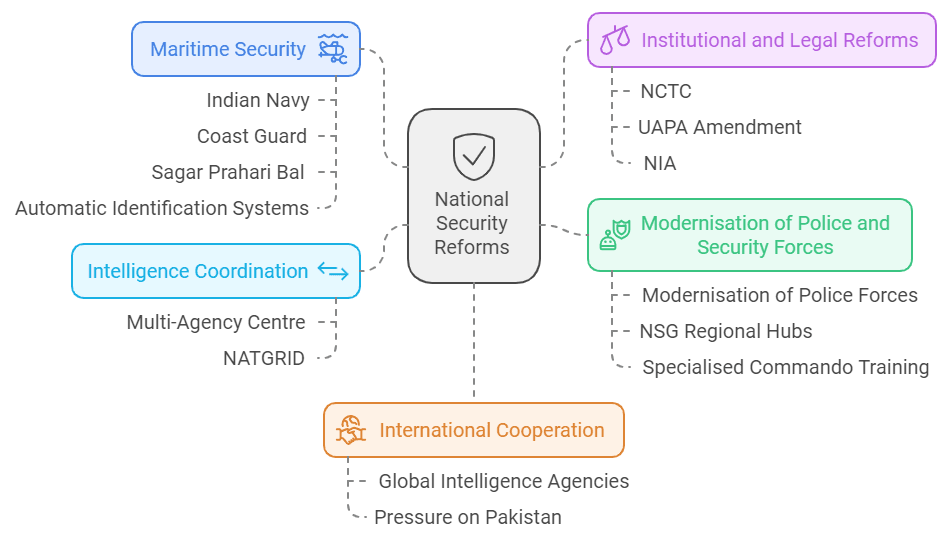Current Affairs 2024 - 26/11 Mumbai Attack: Key Lessons in National Security & Counterterrorism
Feb, 2025
•2 min read
Introduction
The 26/11 Mumbai attacks, orchestrated by the Pakistan-based terror group Lashkar-e-Taiba, exposed critical vulnerabilities in India’s security infrastructure. The multi-target urban terror attack revealed gaps in intelligence sharing, maritime security, and response mechanisms, prompting a comprehensive overhaul of India’s counterterrorism and security measures. However, persistent challenges underscore the need for continued reforms and proactive strategies.
Indian Security Vulnerabilities Exposed by the 26/11 Attacks
- Intelligence Failures
- Lack of real-time intelligence sharing between central and state agencies.
- Absence of actionable intelligence to preempt the attack.
- Maritime Security Weaknesses
- Porous Coastal Borders: Terrorists entered India via unguarded coastal areas using fishing trawlers and inflatable boats.
- Coordination Gaps: Inefficient coordination among the Indian Navy, Coast Guard, and Marine Police hindered coastal monitoring.
- Digital and Cyber Vulnerabilities
- Inability to counter digital propaganda and online radicalisation.
- Advanced communication tools used by attackers to stay connected with handlers.
- Inadequate Training and Response
- Security forces lacked specialised training for handling urban terror situations with simultaneous multi-target attacks.
- Delay in deployment and poor tactical coordination prolonged the crisis.
- Infrastructure Deficiencies
- Ill-equipped state police forces with outdated technology and weapons.
- Lack of rapid response units in key urban centers.

Steps Taken to Strengthen Security Post-26/11
- Maritime Security Reforms
- Indian Navy assigned overall maritime security responsibility; Coast Guard to manage territorial waters.
- Creation of Sagar Prahari Bal for coastal patrolling and rapid response.
- Installation of Automatic Identification Systems (AIS) for vessels over 20 meters.
- Intelligence Coordination
- Strengthened Multi-Agency Centre (MAC) for real-time intelligence sharing.
- Introduction of systems like National Intelligence Grid (NATGRID) to integrate data from multiple databases.
- Institutional and Legal Reforms
- Establishment of National Counter-Terrorism Centre (NCTC) for coordinated counter-terror actions.
- Amendment of UAPA to include proactive steps against terrorism.
- Creation of National Investigation Agency (NIA) for federal oversight of terror cases.
- Modernisation of Police and Security Forces
- Increased funding under the Modernisation of Police Forces scheme.
- Regional hubs of National Security Guard (NSG) set up in Mumbai, Chennai, Kolkata, and Hyderabad.
- Specialised commando training introduced for state police forces.
- International Cooperation
- Enhanced collaboration with global intelligence agencies, including the US and Interpol.
- Pressure on Pakistan through diplomatic channels and the Financial Action Task Force (FATF).

Persistent Challenges in Coastal and National Security
- Monitoring Challenges
- India’s vast 7517 km coastline remains difficult to monitor effectively.
- Smaller fishing vessels, exempt from AIS, remain a security risk.
- Diverse Threat Landscape
- Smuggling, illegal migration, and terror infiltration persist as threats.
- Migrants from neighboring countries pose potential risks.
- Over-reliance on Local Communities
- Dependence on fishermen for intelligence creates vulnerabilities due to fear or lack of awareness.
- Poor Infrastructure
- Continued political interference and insufficient funding hamper the modernisation of state police.
- Need for better urban disaster management plans focusing on terror threats.

Way Forward
- Deterrence and Offensive Strategies
- Institutionalise surgical strikes and airstrikes as a counterterrorism policy.
- Enhanced Coordination and Training
- Conduct multi-agency exercises involving all security stakeholders.
- Strengthen coordination between local police and specialised forces like NSG.
- Empowered Decision-Making
- Grant greater discretion to security officials for rapid decision-making during emergencies.
- Building Cybersecurity Expertise
- Integrate cyber and physical security measures in training modules.
- Community Participation
- Establish community-based 'Awake Cells' to gather real-time intelligence.
- Sensitise local populations through awareness campaigns on maritime security.

Conclusion
The 26/11 attacks were a grim reminder of India’s vulnerabilities, but they also catalysed critical reforms in counterterrorism and security mechanisms. While significant strides have been made in maritime security, intelligence coordination, and institutional capacity, persistent gaps demand sustained efforts. A comprehensive, multi-stakeholder approach, coupled with empowered decision-making and community involvement, is essential to safeguard India’s security in an increasingly complex threat environment.

![Aravali Range in News [UPSC 2025]](/_next/image?url=https%3A%2F%2Fblog-media.superkalam.com%2Faravali_hills_f4a51f37bf.jpeg&w=3840&q=75)
![MGNREGA Vs VB-G RAM G [UPSC 2025]](/_next/image?url=https%3A%2F%2Fblog-media.superkalam.com%2FMGNREGA_vs_GRAMG_ea46241736.jpeg&w=3840&q=75)